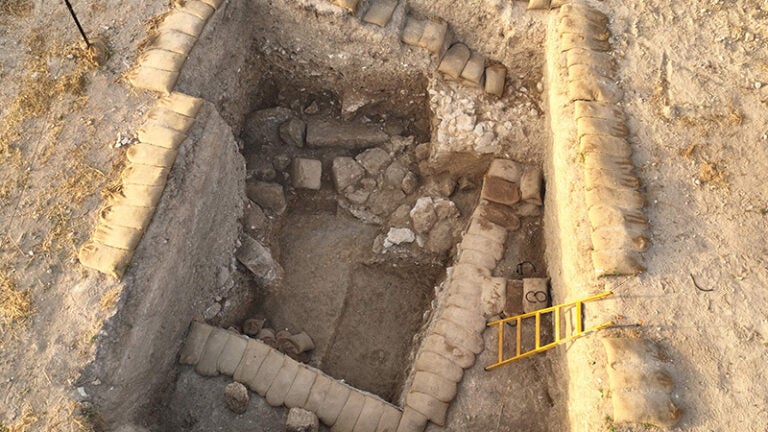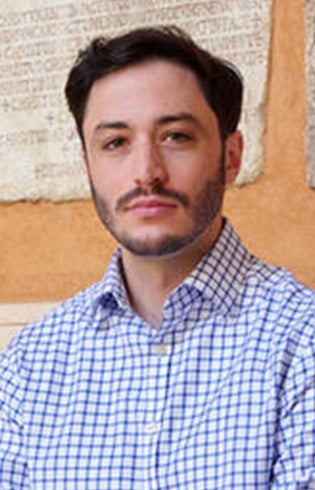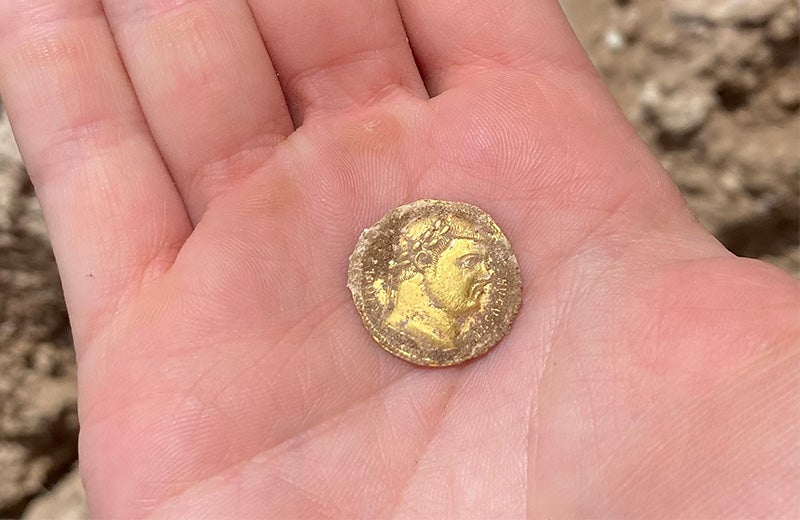
First Roman military amphitheater discovered in Israel’s Armageddon
In 1902, the archeologist Gottlieb Schumacher began digging around Armageddon.
He was conducting the first survey of the ancient city of Megiddo in northern Israel, better known by the biblical name Armageddon, the Greek translation of the Aramaic “Har Megiddo” (the hill of Megiddo).
The Christian Bible prophesizes that the armies of the world will gather at Armageddon for a last battle at the end of times, and the name has gradually come to denote apocalypse in general. But the famed city is indeed real, and has been home to human civilization almost continuously since the Neolithic period.
Schumacher’s primary interest was the ancient city of Megiddo, but he did do a bit of digging in the surrounding area. He uncovered evidence of occupation by the Roman army and noted a large, circular depression in the earth. An ancient amphitheater, he guessed.
It wasn’t until 2013 that a team of researchers began the first official excavation of the army base that Schumacher hypothesized was in the vicinity. They uncovered both the walls and administrative center of the Roman 6th Legion’s base and hypothesized that the odd depression was a military amphitheater associated with the legion.
In July, scholars from the USC Dornsife College of Letters, Arts and Sciences finally proved this hypothesis to be correct. It’s the first Roman military amphitheater ever uncovered in the Southern Levant, which encompasses Israel, Jordan and Palestine.
Into the pit

Mark Letteney has a forthcoming book on incarceration in the ancient Mediterranean. (Photo: Courtesy of Mark Letteney.)
Excavation of the amphitheater was led by historian and archaeologist Mark Letteney, a postdoctoral fellow at the USC Mellon Humanities in a Digital World Program, headquartered at USC Dornsife.
Letteney, who first worked on the site in 2015, studies the emergence of Christianity in Rome, incarceration in Mediterranean antiquity and military infrastructure in Roman Palestine.
This season was his team’s first full excavation of the amphitheater. Their work revealed enough of the structure to confirm the hypothesis that it was built for the local military base, occupied by Legio VI Ferrata (the 6th Ironclad Legion), which protected Rome’s holdings in what was then the Province of Judea. The base is currently being excavated by the Legio Project, part of the Jezreel Valley Regional Project that is investigating the many human civilizations that have occupied the area.
Military amphitheaters were generally smaller than the civic amphitheaters designed for gladiator combat or executions (structures made famous again by the 2000 film Gladiator). These were used for troop training, marching, speeches and, perhaps most important, fun.
“When soldiers are the occupying force (which is demoralizing), far from home, and don’t speak the local language, they don’t have a lot of outlets. So, they played games and put on public events for entertainment,” says Letteney.
The site is particularly interesting because of its layered history, says Letteney. Prior to the amphitheater, locals had begun digging clay from the rich soil to create ceramics. When the Romans arrived, they likely also used the clay to make roof tiles, floor tiles and pipes for their sprawling base.
Over time, a large pit formed from excavation, and eventually, Letteney says, the legion decided to take advantage of the depression. They capped the pit’s edges with a stone surface and installed seating and gates for access. The Romans would have commissioned military engineers, similar to the modern Army Corps of Engineers, to erect the structure.
The idea that the Romans first excavated clay from the pit before turning it into an amphitheater still requires some testing. Letteney and his team studied clay from the site and it appears to be identical to the tiles made by the legion, but findings are preliminary. They next need to fire the clay and then look at it under a microscope to draw a firm conclusion.
Gold rush
Assisting Letteney in his work was Krysta Fauria, a first-year religion PhD student focused on early Christianity and the gospels. It was her first time on an archeological site, and she credits Letteney with getting her there.
“One day Mark was talking about how he was going on his dig, and off the cuff he asked me if I wanted to go,” says Fauria. “I was like, ‘I don’t have any experience, I don’t have any training, I don’t see how I would be able to.’ And he said, ‘You’re in school, that’s the point: You’re being trained.’”

Religion PhD student Krysta Fauria uncovered a gold coin dating from 295 AD. (Photo: Courtesy of Krysta Fauria.)
Letteney helped Fauria apply for funding, and she secured a prestigious William G. Dever Fellowship from the American Society for Overseas Research. Once on the site, she quickly made herself useful: It was Fauria who found a gold coin that has helped the team more accurately date the structures.
After digging some 6 feet below the ground at the excavation site one afternoon, Fauria’s spotted something sparkling in the sun.
“All of a sudden, I struck loose some dirt, and this shiny coin appears. Everybody just kind of gathered around; it was a really crazy thing,” says Fauria. The coin, which seems to have lost none of its brilliance over the centuries, dates from 245 AD, during the reign of Emperor Diocletian.
For Fauria, this experience has helped her connect viscerally with her new field of studies, after a former career as a journalist with Associated Press News.
“Being in Israel and Palestine, you realize that it’s important for people who study this to go, even though obviously we’re separated by a lot of time, to get a feel for the geography and the climate,” says Fauria.
Research on the site will continue next summer, with Letteney back in the trenches. He’s hoping to uncover more of the east and west gates of the amphitheater. This will allow them to do more precise dating and get a better sense of the construction style of those Roman engineers from nearly 1,700 years ago.